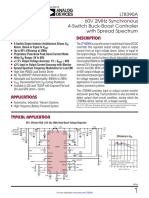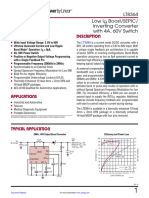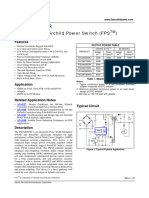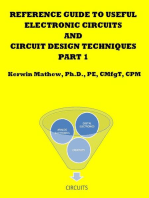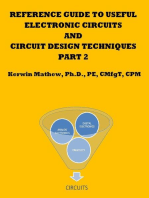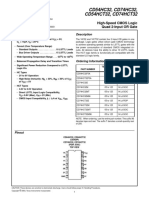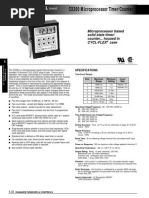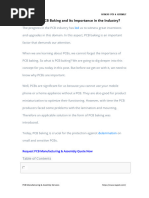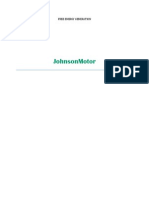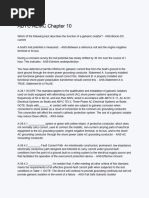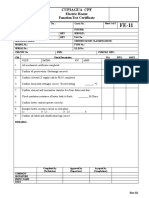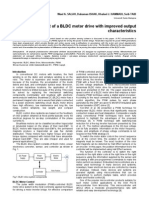Features Description: Lt3791 60V 4-Switch Synchronous Buck-Boost Led Driver Controller
Features Description: Lt3791 60V 4-Switch Synchronous Buck-Boost Led Driver Controller
Uploaded by
Thallys BatistaCopyright:
Available Formats
Features Description: Lt3791 60V 4-Switch Synchronous Buck-Boost Led Driver Controller
Features Description: Lt3791 60V 4-Switch Synchronous Buck-Boost Led Driver Controller
Uploaded by
Thallys BatistaOriginal Title
Copyright
Available Formats
Share this document
Did you find this document useful?
Is this content inappropriate?
Copyright:
Available Formats
Features Description: Lt3791 60V 4-Switch Synchronous Buck-Boost Led Driver Controller
Features Description: Lt3791 60V 4-Switch Synchronous Buck-Boost Led Driver Controller
Uploaded by
Thallys BatistaCopyright:
Available Formats
LT3791
60V 4-Switch Synchronous
Buck-Boost LED Driver
Controller
Features Description
n 4-Switch Single Inductor Architecture Allows VIN The LT®3791 is a synchronous 4-switch buck-boost LED
Above, Below or Equal to VOUT driver controller. The controller can regulate LED current
n Synchronous Switching: Up to 98.5% Efficiency up to 52V of LED string with input voltages above, below,
n Wide V Range: 4.7V to 60V or equal to the output voltage. The constant-frequency,
IN
n Wide V
OUT Range: 0V to 60V (52V LED) forced-continuous current mode architecture allows its
n ±6% LED Current Accuracy: 0V ≤ V
LED < 52V frequency to be adjusted or synchronized from 200kHz to
n True Color PWM™ and Analog Dimming 700kHz. No top MOSFET refresh switching cycle is needed
n LED and Input Current Regulation with Current in buck or boost operation. With 60V input, 60V output
Monitor Outputs capability and seamless transitions between operating
n No Top MOSFET Refresh in Buck or Boost regions, the LT3791 is ideal for LED driver applications in
n V
OUT Disconnected From VIN During Shutdown automotive, industrial, and even battery-powered systems.
n Open or Shorted LED Fault Protection
n Capable of 100W or Greater per IC
For new designs we recommend the LT8391: 60V syn-
n 38-Lead TSSOP with Exposed Pad
chronous 4-switch, buck-boost LED controller due to its
numerous performance improvements over the LT3791.
Applications L, LT, LTC, LTM, Linear Technology and the Linear logo are registered and True Color PWM
is a trademark of Analog Devices, Inc. All other trademarks are the property of their respective
owners.
n Automotive Head Lamps/Running Lamps
n General Purpose Lighting
Typical Application
98.5% Efficient 100W (33.3V 3A) Buck-Boost LED Driver
VIN 2.2µF
15V TO 58V 100V
0.003Ω
×5
VIN INTVCC
1µF 4.7µF
50Ω BST2 Efficiency vs VIN
IVINN BST1 0.1µF 4.7µF 100
470nF 50V
TG1 0.1µF 1M
499k IVINP ×5
SWI 98
EN/UVLO 10µH BOOST
OVLO BG1 34.2k BUCK
15.8k INTVCC
BUCK-BOOST
EFFICIENCY (%)
LT3791 SNSP 96
200k 200k
28k 3A, 100W
SHORTLED 0.004Ω 0.033Ω
LED POWER
OPENLED 94
SNSN
PGND
PWM 92
BG2
IVINMON
SW2
ISMON
TG2 90
CLKOUT 10 20 30 40 50 60
FB
VREF INPUT VOLTAGE (V)
ISP
CTRL 3791 TA01b
0.1µF ISN
PWMOUT
SS SYNC VC RT SGND
10nF 22nF 86.6k
300kHz
3791 TA01a
3791fc
For more information www.linear.com/LT3791 1
LT3791
Absolute Maximum Ratings Pin Configuration
(Note 1)
Supply Voltages TOP VIEW
Input Supply (VIN)......................................................60V CTRL 1 38 OVLO
SW1, SW2.......................................................–1V to 60V SS 2 37 FB
OPENLED, SHORTLED................................................15V PWM 3 36 VC
EN/UVLO, IVINP, IVINN, ISP, ISN...............................60V OPENLED 4 35 RT
5 34 SYNC
INTVCC, (BST1-SW1), (BST2-SW2)..............................6V SHORTLED
VREF 6 33 CLKOUT
TEST2, SYNC, RT, CTRL, OVLO, PWM........................6V
ISMON 7 32 TEST2
IVINMON, ISMON, FB, SS, VC, VREF.............................6V 8
IVINMON 31 PWMOUT
IVINP-IVINN, ISP-ISN, SNSP-SNSN........................±0.5V EN/UVLO 9 30 SGND
SNSP, SNSN............................................................±0.3V IVINP 10
39
29 TEST1
SGND
Operating Junction Temperature (Notes 2, 3) IVINN 11 28 SNSN
LT3791E/LT3791I................................ –40°C to 125°C VIN 12 27 SNSP
LT3791H............................................. –40°C to 150°C INTVCC 13 26 ISN
LT3791MP.......................................... –55°C to 150°C TG1 14 25 ISP
Storage Temperature Range................... –65°C to 150°C BST1 15 24 TG2
Lead Temperature (Soldering, 10 sec).................... 300°C SW1 16 23 NC
PGND 17 22 BST2
BG1 18 21 SW2
BG2 19 20 PGND
FE PACKAGE
38-LEAD PLASTIC TSSOP
TJMAX = 150°C, θJA = 28°C/W
EXPOSED PAD (PIN 39) IS SGND, MUST BE SOLDERED TO PCB
Order Information http://www.linear.com/product/LT3791#orderinfo
LEAD FREE FINISH TAPE AND REEL PART MARKING* PACKAGE DESCRIPTION TEMPERATURE RANGE
LT3791EFE#PBF LT3791EFE#TRPBF LT3791FE 38-Lead Plastic TSSOP –40°C to 125°C
LT3791IFE#PBF LT3791IFE#TRPBF LT3791FE 38-Lead Plastic TSSOP –40°C to 125°C
LT3791HFE#PBF LT3791HFE#TRPBF LT3791FE 38-Lead Plastic TSSOP –40°C to 150°C
LT3791MPFE#PBF LT3791MPFE#TRPBF LT3791FE 38-Lead Plastic TSSOP –55°C to 150°C
Consult LTC Marketing for parts specified with wider operating temperature ranges. *The temperature grade is identified by a label on the shipping container.
For more information on lead free part marking, go to: http://www.linear.com/leadfree/
For more information on tape and reel specifications, go to: http://www.linear.com/tapeandreel/. Some packages are available in 500 unit reels through
designated sales channels with #TRMPBF suffix.
Electrical
Characteristics The l denotes the specifications which apply over the full operating
junction temperature range, otherwise specifications are at TA = 25°C (Note 2). VIN = 12V, VEN/UVLO = 12V unless otherwise noted.
PARAMETER CONDITIONS MIN TYP MAX UNITS
Input
VIN Operating Voltage 4.7 60 V
VIN Shutdown IQ VEN/UVLO = 0V 0.1 1 µA
VIN Operating IQ (Not Switching) FB = 1.3V, RT = 59.0k 3.0 4 mA
3791fc
2 For more information www.linear.com/LT3791
LT3791
Electrical
Characteristics The l denotes the specifications which apply over the full operating
junction temperature range, otherwise specifications are at TA = 25°C (Note 2). VIN = 12V, VEN/UVLO = 12V unless otherwise noted.
PARAMETER CONDITIONS MIN TYP MAX UNITS
Logic Inputs
EN/UVLO Falling Threshold l 1.16 1.2 1.24 V
EN/UVLO Rising Hysteresis 15 mV
EN/UVLO Input Low Voltage IVIN Drops Below 1µA 0.3 V
EN/UVLO Pin Bias Current Low VEN/UVLO = 1V 2 3 4 µA
EN/UVLO Pin Bias Current High VEN/UVLO = 1.6V 10 100 nA
CTRL Input Bias Current VCTRL = 1V 20 50 nA
CTRL Latch-Off Threshold 175 mV
OVLO Rising Shutdown Voltage l 2.85 3 3.15 V
OVLO Falling Hysteresis 75 mV
Regulation
VREF Voltage l 1.96 2.00 2.04 V
VREF Line Regulation 4.7V < VIN < 60V 0.002 0.04 %/V
V(ISP-ISN) Threshold VCTRL = 2V 97.5 100 102.5 mV
l 94 100 106 mV
VCTRL = 1100mV 87 90 93 mV
l 84 90 96 mV
VCTRL = 700mV 47.5 50 52.5 mV
l 46 50 54 mV
VCTRL = 300mV 6.5 10 13.5 mV
l 5 10 15 mV
ISP Bias Current 110 µA
ISN Bias Current 20 µA
LED Current Sense Common Mode Range 0 60 V
LED Current Sense Amplifier gm 890 µS
ISMON Monitor Voltage V(ISP-ISN) = 100mV l 0.96 1 1.04 V
Input Current Sense Threshold V(IVINP-IVINN) 3V ≤ VIVINP ≤ 60V l 46.5 50 54 mV
IVINP Bias Current 90 µA
IVINN Bias Current 20 µA
Input Current Sense Common Mode Range 3 60 V
Input Current Sense Amplifier gm 2.12 mS
IVINMON Monitor Voltage V(IVINP-IVINN) = 50mV l 0.96 1 1.04 V
FB Regulation Voltage 1.194 1.2 1.206 V
l 1.176 1.2 1.220 V
FB Line Regulation 4.7V < VIN < 60V 0.002 0.025 %/V
FB Amplifier gm 565 µS
FB Pin Input Bias Current FB in Regulation 100 200 nA
VC Standby Input Bias Current PWM = 0V –20 20 nA
VSENSE(MAX) (VSNSP-SNSN) Boost l 42 51 60 mV
Buck l –56 –47.5 –39 mV
Fault
SS Pull-Up Current VSS = 0V 14 µA
SS Discharge Current 1.4 µA
FB Overvoltage Rising Threshold 1.22 1.25 V
Open LED Rising Threshold (VFB) V(ISP-ISN) = 0V l 1.127 1.15 1.173 V
3791fc
For more information www.linear.com/LT3791 3
LT3791
Electrical
Characteristics The l denotes the specifications which apply over the full operating
junction temperature range, otherwise specifications are at TA = 25°C (Note 2). VIN = 12V, VEN/UVLO = 12V unless otherwise noted.
PARAMETER CONDITIONS MIN TYP MAX UNITS
Open LED Falling Threshold (VFB) l 1.078 1.1 1.122 V
Open LED Falling Threshold (V(ISP-ISN)) VFB = 1.2V 5 10 15 mV
Short LED Falling Threshold (VFB) 380 400 450 mV
OPENLED Pin Output Impedance 1.1 2.0 kΩ
SHORTLED Pin Output Impedance 1.1 2.0 kΩ
SS Latch-Off Threshold 1.75 V
SS Reset Threshold 0.2 V
Oscillator
Switching Frequency RT = 147k 190 200 210 kHz
RT = 59.0k 380 400 420 kHz
RT = 29.1k 665 700 735 kHz
SYNC Frequency 200 700 kHz
SYNC Pin Resistance to GND 90 kΩ
SYNC Threshold Voltage 0.3 1.5 V
Internal VCC Regulator
INTVCC Regulation Voltage 4.8 5 5.2 V
Dropout (VIN – INTVCC) IINTVCC = –10mA, VIN = 5V 240 350 mV
INTVCC Undervoltage Lockout 3.1 3.5 3.9 V
INTVCC Current Limit VINTVCC = 4V 67 mA
PWM
PWM Threshold Voltage 0.3 1.5 V
PWM Pin Resistance to GND 90 kΩ
PWMOUT Pull-Up Resistance 10 20 Ω
PWMOUT Pull-Down Resistance 5 10 Ω
NMOS Drivers
TG1, TG2 Gate Driver On-Resistance VBST – VSW = 5V
Gate Pull-Up 2.6 Ω
Gate Pull-Down 1.7 Ω
BG1, BG2 Gate Driver On-Resistance VINTVCC = 5V
Gate Pull-Up 3 Ω
Gate Pull-Down 1.2 Ω
TG Off to BG On Delay CL = 3300pF 60 ns
BG Off to TG On Delay CL = 3300pF 60 ns
TG1, TG2, tOFF(MIN) RT = 59.0k 240 320 ns
Note 1: Stresses beyond those listed under Absolute Maximum Ratings operating junction temperature range. The LT3791MP is guaranteed to
may cause permanent damage to the device. Exposure to any Absolute meet performance specifications over the –55°C to 150°C operating
Maximum Rating condition for extended periods may affect device junction temperature range. High junction temperatures degrade operating
reliability and lifetime. lifetimes. Operating lifetime is derated for junction temperatures greater
Note 2: The LT3791E is guaranteed to meet performance from 0°C than 125°C.
to 125°C junction temperature. Specification over the -40°C to Note 3: The LT3791 includes overtemperature protection that is intended
125°C operating junction temperature range are assured by design, to protect the device during momentary overload conditions. Junction
characterization and correlation with statistical process controls. temperature will exceed the maximum operating junction temperature
The LT3791I is guaranteed to meet performance specifications over the when overtemperature protection is active. Continuous operation above
–40°C to 125°C operating junction temperature range. The LT3791H is the specified absolute maximum operating junction temperature may
guaranteed to meet performance specifications over the –40°C to 150°C impair device reliability.
3791fc
4 For more information www.linear.com/LT3791
LT3791
Typical Performance Characteristics TA = 25°C, unless otherwise noted.
INTVCC Dropout Voltage INTVCC Current Limit
vs Current, Temperature INTVCC Voltage vs Temperature vs Temperature
2.5 5.20 90
TA = 150°C
TA = 25°C 5.15 80
2.0 TA = –50°C
INTVCC CURRENT LIMIT (mA)
70
5.10
60
VIN-VINTVCC (V)
1.5 5.05 VIN = 60V
INTVCC (V)
50
5.00
VIN = 12V 40
1.0
4.95
30
4.90 20
0.5
4.85 10
0 4.80 0
0 10 20 30 40 –50 –25 0 25 50 75 100 125 150 –50 –25 0 25 50 75 100 125 150
LDO CURRENT (mA) TEMPERATURE (°C) TEMPERATURE (°C)
3791 G01 3791 G02 3791 G03
INTVCC Load Regulation VREF Voltage vs Temperature VREF Load Regulation
6.00 2.04 2.20
5.75 2.03 2.15
5.50 2.02 2.10
5.25 2.01 2.05
INTVCC (V)
VREF (V)
5.00 2.00 VREF (V) 2.00
4.75 1.99 1.95
4.50 1.98 1.90
VIN = 60V
4.25 1.97 VIN = 12V 1.85
VIN = 4.7V
4.00 1.96 1.80
0 10 20 30 40 50 60 70 –50 –25 0 25 50 75 100 125 150 0 50 100 150 200 250 300 350 400
ILOAD (mA) TEMPERATURE (°C) IREF (µA)
3791 G04 3791 G05 3791 G06
V(ISP-ISN) Threshold
V(ISP-ISN) Threshold vs VCTRL V(ISP-ISN) Threshold vs VISP vs Temperature
110 108 108
VIN = 12V
100
106 106
90
80 104 104
70
V(ISP-ISN) (mV)
V(ISP-ISN) (mV)
V(ISP-ISN) (mV)
102 102
60
100 100
50
40 98 98
30
96 96
20 VISP = 60V
94 94 VISP = 12V
10
VISP = 0V
0 92 92
0 0.2 0.4 0.6 0.8 1.0 1.2 1.4 1.6 1.8 2.0 0 10 20 30 40 50 60 –50 –25 0 25 50 75 100 125 150
VCTRL (V) VISP (V) TEMPERATURE (°C)
3791 G07 3791 G08 3791 G09
3791fc
For more information www.linear.com/LT3791 5
LT3791
Typical Performance Characteristics TA = 25°C, unless otherwise noted.
V(ISP-ISN) Threshold vs VFB ISMON Voltage vs Temperature ISMON Voltage vs V(ISP-ISN)
120 1.04 1.0
VIN = 12V
V(ISP-ISN) = 100mV 0.9
1.03
100
0.8
1.02
0.7
80
V(ISP-ISN) (mV)
1.01 0.6
VISMON (V)
VISMON (V)
60 1.00 0.5
0.4
0.99
40
0.3
0.98
20 0.2
0.97 0.1
0 0.96 0
1.17 1.18 1.19 1.20 1.21 1.22 1.23 –50 –25 0 25 50 75 100 125 150 0 10 20 30 40 50 60 70 80 90 100
VFB (V) TEMPERATURE (°C) V(ISP-ISN) (mV)
3791 G10 3791 G11 3791 G12
V(IVINP-IVINN) Threshold V(IVINP-IVINN) Threshold
vs Temperature vs VIVINP IVINMON Voltage vs Temperature
56 52.0 1.04
VIVINP = 12V
54 51.5 1.03 V(IVINP-VINN) = 50mV
51.0 1.02
52
V(IVINP-IVINN) (mV)
V(IVINP-IVINN) (mV)
VIVINP = 60V 50.5 1.01
VIVINMON (V)
50
VIVINP = 3V 50.0 1.00
48
49.5 0.99
46
49.0 0.98
44 48.5 0.97
42 48.0 0.96
–50 –25 0 25 50 75 100 125 150 0 10 20 30 40 50 60 –50 –25 0 25 50 75 100 125 150
TEMPERATURE (°C) VIVINP (V) TEMPERATURE (°C)
3791 G13 3791 G14 3791 G15
FB Regulation Voltage SHORTLED Threshold
V(IVINP-IVINN) Threshold vs VFB vs Temperature vs Temperature
60 1.24 0.500
1.23 0.475
50
1.22 0.450
V(IVINP-IVINSN) (mV)
40
FB VOLTAGE (V)
1.21 0.425 RISING
VFB (V)
30 1.20 0.400
FALLING
1.19 0.375
20
1.18 0.350
10 VIN = 60V
1.17 VIN = 12V 0.325
VIN = 4.7V
0 1.16 0.300
1.17 1.18 1.19 1.20 1.21 1.22 1.23 –50 –25 0 25 50 75 100 125 150 –50 –25 0 25 50 75 100 125 150
VFB (V) TEMPERATURE (°C) TEMPERATURE (°C)
3791 G16 3791 G17 3791 G18
3791fc
6 For more information www.linear.com/LT3791
LT3791
Typical Performance Characteristics TA = 25°C, unless otherwise noted.
OPENLED Threshold
vs Temperature OVLO Threshold vs Temperature Soft-Start Current vs Temperature
1.200 3.3 16
1.175 3.2 14 CHARGING
RISING
1.150 3.1 12
OVLO THRESHOLD (V)
RISING
FB VOLTAGE (V)
1.125 3.0 10
ISS (µA)
FALLING
1.100 2.9 FALLING 8
1.075 2.8 6
1.050 2.7 4
2.6 2 DISCHARGING
1.025
1.000 2.5 0
–50 –25 0 25 50 75 100 125 150 –50 –25 0 25 50 75 100 125 150 –50 –25 0 25 50 75 100 125 150
TEMPERATURE (°C) TEMPERATURE (°C) TEMPERATURE (°C)
3791 G19 3791 G20 3791 G21
Supply Current vs Input Voltage EN/UVLO Pin Current EN/UVLO Threshold Voltage
4.0 8 1.30
VEN/ULO = 1V
1.28
3.5 7
1.26
EN/UVLO PIN CURRENT (µA)
3.0 6
EN/UVLO THRESHOLD (V)
1.24
2.5 5 1.22 RISING
IQ (mA)
2.0 4 1.20
1.5 1.18
3 FALLING
1.16
1.0 2
TA = 150°C 1.14
0.5 TA = 25°C 1 1.12
TA = –50°C
0 0 1.10
0 10 20 30 40 50 60 –50 –25 0 25 50 75 100 125 150 –50 –25 0 25 50 75 100 125 150
VIN (V) TEMPERATURE (°C) TEMPERATURE (°C)
3791 G22 3791 G23 3791 G24
Oscillator Frequency TG1, TG2 Minimum On-Time TG1, TG2 Minimum Off-Time
vs Temperature vs Temperature vs Temperature
800 100 350
TG2
700 90 300
TG1, TG2 MINIMUM OFF-TIME (ns)
TG1, TG2 MINIMUM ON-TIME (ns)
RT = 29.1k fSW = 200kHz
SWITCHING FREQUENCY (kHz)
600 80 TG1
250
fSW = 400kHz
500 70
RT = 59.0k 200
400 60
fSW = 700kHz
150
300 50
RT = 147k 100
200 40
30 50
100
0 20 0
–50 –25 0 25 50 75 100 125 150 –50 –25 0 25 50 75 100 125 150 –50 –25 0 25 50 75 100 125 150
TEMPERATURE (°C) TEMPERATURE (°C) TEMPERATURE (˚C)
3791 G25 3791 G26 3791 G27
3791fc
For more information www.linear.com/LT3791 7
LT3791
Typical Performance Characteristics TA = 25°C, unless otherwise noted.
V(BST1-SW1), V(BST2-SW2) UVLO BG1, BG2 Driver On-Resistance TG1, TG2 Driver On-Resistance
vs Temperature vs Temperature vs Temperature
3.9 4.5 4.0
3.8 4.0 3.5
RISING PULL-UP
V(BST1-SW1), V(BST2,SW2) (V)
3.5
BG1, BG2 RESISTANCE (Ω)
TG1, TG2 RESISTANCE (Ω)
3.7 3.0 PULL-UP
3.0
3.6 2.5
2.5
PULL-DOWN
3.5 2.0
2.0
3.4 PULL-DOWN 1.5
1.5
FALLING
3.3 1.0
1.0
3.2 0.5 0.5
3.1 0 0
–50 –25 0 25 50 75 100 125 150 –50 –25 0 25 50 75 100 125 150 –50 –25 0 25 50 75 100 125 150
TEMPERATURE (°C) TEMPERATURE (°C) TEMPERATURE (°C)
3791 G28 3791 G29 3791 G30
PWMOUT On-Resistance V(SNSP-SNSN) Buck Threshold
vs Temperature VC Voltage vs Duty Cycle vs VC
14 1.6 60
V(SNSP-SNSN) = 0V
12 1.4
40
BG2
PWMOUT RESISTANCE (Ω)
1.2
10 PULL-UP
V(SNSP-SNSN) (mV)
20
1.0
8 BG1
VC (V)
0.8 0
6 PULL-DOWN
0.6
–20
4
0.4
2 –40
0.2
0 0 –60
–50 –25 0 25 50 75
100 125 150 0 20 40 60 80 100 0.6 0.8 1.0 1.2 1.4 1.6 1.8
TEMPERATURE (˚C) DUTY CYCLE (%) VC (V)
3791 G31 3791 G32 3791 G33
V(SNSP-SNSN) Buck Threshold V(SNSP-SNSN) Boost Threshold V(SNSP-SNSN) Boost Threshold
vs Temperature vs VC vs Temperature
60 60 60
VC(MIN) VC(MAX)
40 40 40
V(SNSP-SNSN) THRESHOLD (mV)
V(SNSP-SNSN) THRESHOLD (mV)
20 20
V(SNSP-SNSN) (mV)
20
0 0
0
–20 –20
–20
–40 –40
–40 VC(MAX)
–60 –60 VC(MIN)
–60 –80 –80
–50 –25 0 25 50 75 100 125 150 0.6 0.8 1.0 1.2 1.4 1.6 1.8 –50 –25 0 25 50 75 100 125 150
TEMPERATURE (°C) VC (V) TEMPERATURE (˚C)
3791 G34 3791 G35 3791 G36
3791fc
8 For more information www.linear.com/LT3791
LT3791
Pin Functions
CTRL (Pin 1): Current Sense Threshold Adjustment Pin for EN/UVLO (Pin 9): Enable Control Pin. Forcing an accurate
Analog Dimming. Regulating threshold V(ISP-ISN) is 1/10th 1.2V falling threshold with an externally programmable
of (VCTRL – 200mV). CTRL linear range is from 200mV hysteresis is generated by the external resistor divider
to 1.1V. For VCTRL > 1.3V, the current sense threshold is and a 3µA pull-down current. Above the 1.2V (typical)
constant at the full-scale value of 100mV. For 1.1V < VCTRL threshold (but below 6V), EN/UVLO input bias current is
< 1.3V, the dependence of the current sense threshold sub-µA. Below the falling threshold, a 3µA pull-down cur-
upon VCTRL transitions from a linear function to a con- rent is enabled so the user can define the hysteresis with
stant value, reaching 98% of full scale by VCTRL = 1.2V. the external resistor selection. An undervoltage condition
Connect CTRL to VREF for the 100mV default threshold. resets soft-start. Tie to 0.3V, or less, to disable the device
Force less than 175mV (typical) to stop switching. Do not and reduce VIN quiescent current below 1µA.
leave this pin open. IVINP (Pin 10): Positive Input for the Input Current Limit
SS (Pin 2): Soft-start reduces the input power sources and Monitor. Input bias current for this pin is typically 90µA.
surge current by gradually increasing the controller’s cur- IVINN (Pin 11): Negative Input for the Input Current Limit
rent limit. A minimum value of 10nF is recommended on
and Monitor. The input bias current for this pin is typically
this pin. SS is used as a timer when an open or shorted
20µA.
LED condition occurs. A 500k resistor placed from SS to
VREF will latch the part off in the event of a fault. If left VIN (Pin 12): Main Input Supply. Bypass this pin to PGND
open, a 1.4µA current source pulls down on SS and the with a capacitor.
part restarts in a fault. INTVCC (Pin 13): Internal 5V Regulator Output. The driver
PWM (Pin 3): A signal low turns off switches, idles switch- and control circuits are powered from this voltage. Bypass
ing and disconnects the VC pin from all external loads. The this pin to PGND with a minimum 4.7µF ceramic capacitor.
PWMOUT pin follows the PWM pin. PWM has an internal TG1 (Pin 14): Top Gate Drive. Drives the top N-channel
100k pull-down resistor. If not used, connect to INTVCC. MOSFET with a voltage equal to INTVCC superimposed on
OPENLED (Pin 4): An open-drain pull-down on OPENLED the switch node voltage SW1.
asserts if FB is greater than 1.15V (typical) and V(ISP-ISN) BST1 (Pin 15): Bootstrapped Driver Supply. The BST1 pin
is less than 10mV (typical). To function, the pin requires swings from a diode voltage below INTVCC up to a diode
an external pull-up resistor. voltage below VIN + INTVCC.
SHORTLED (Pin 5): An open-drain pull-down on SW1 (Pin 16): Switch Node. SW1 pin swings from a diode
SHORTLED asserts if FB is less than 400mV (typical). voltage drop below ground up to VIN.
To function, the pin requires an external pull-up resistor.
PGND (Pins 17, 20): Power Ground. Connect these pins
VREF (Pin 6): Voltage Reference Output Pin, Typically 2V. closely to the source of the bottom N-channel MOSFET.
This pin drives a resistor divider for the CTRL pin, either
for analog dimming or for temperature limit/compensa- BG1 (Pin 18): Bottom Gate Drive. Drives the gate of the
tion of the LED load. Can supply up to 200µA of current. bottom N-channel MOSFET between ground and INTVCC.
ISMON (Pin 7): Monitor pin that produces a voltage that BG2 (Pin 19): Bottom Gate Drive. Drives the gate of the
is ten times the voltage V(ISP-ISN). ISMON will equal 1V bottom N-channel MOSFET between ground and INTVCC.
when V(ISP-ISN) = 100mV. SW2 (Pin 21): Switch Node. SW2 pin swings from a diode
IVINMON (Pin 8): Monitor pin that produces a voltage voltage drop below ground up to VOUT.
that is twenty times the voltage V(IVINP-IVINN). IVINMON BST2 (Pin 22): Bootstrapped Driver Supply. The BST2 pin
will equal 1V when V(IVINP-IVINN) = 50mV. swings from a diode voltage below INTVCC up to a diode
voltage below VOUT + INTVCC.
3791fc
For more information www.linear.com/LT3791 9
LT3791
Pin Functions
NC (Pin 23): No Connect Pin. Leave this pin floating. TEST2 (Pin 32): This pin is used for testing purposes only
and must be connected to INTVCC (Pin 13) for the part to
TG2 (Pin 24): Top Gate Drive. Drives the top N-channel
operate properly.
MOSFET with a voltage equal to INTVCC superimposed on
the switch node voltage SW2. CLKOUT (Pin 33): Clock Output Pin. An in-phase clock is
provided at the oscillator frequency to allow for synchro-
ISP (Pin 25): Connection Point for the Positive Terminal nizing two devices for extending output power capability.
of the Output Current Feedback Resistor.
SYNC (Pin 34): External Synchronization Input Pin. This
ISN (Pin 26): Connection Point for the Negative Terminal pin is internally terminated to GND with a 90k resistor.
of the Output Current Feedback Resistor. The rising edge will be synchronized with the rising edge
SNSP (Pin 27): The Positive Input to the Current Sense of the SYNC signal.
Comparator. The VC pin voltage and controlled offsets RT (Pin 35): Frequency Set Pin. Place a resistor to GND
between the SNSP and SNSN pins, in conjunction with a
to set the internal frequency. The range of oscillation is
resistor, set the current trip threshold.
200kHz to 700kHz.
SNSN (Pin 28): The Negative Input to the Current Sense
VC (Pin 36): Current Control Threshold and Error Amplifier
Comparator. Compensation Point. The current comparator threshold
TEST1 (Pin 29): This pin is used for testing purposes only increases with this control voltage. The voltage ranges
and must be connected to SGND for the part to operate from 0.7V to 1.9V.
properly. FB (Pin 37): Voltage Loop Feedback Pin. FB is intended
SGND (Pin 30, Exposed Pad Pin 39): Signal Ground. for LED protection of an open or shorted LED event. The
All small-signal components and compensation should internal transconductance amplifier with output VC will
connect to this ground, which should be connected to regulate FB to 1.2V (typical) through the DC/DC converter.
PGND at a single point. Solder the exposed pad directly If the FB input is regulating the loop and V(ISP-ISN) < 10mV,
to the ground plane. the OPENLED pull-down is asserted. If the FB pin is less
than 400mV, the SHORTLED pull-down is asserted.
PWMOUT (Pin 31): Buffered Version of PWM Signal for
Driving LED Load Disconnect N-Channel MOSFET. The OVLO (Pin 38): Overvoltage Input Pin. This pin is used for
PWMOUT pin is driven from INTVCC. Use of a MOSFET OVLO, if OVLO > 3V then SS is pulled low, the part stops
with a gate cutoff voltage higher than 1V is recommended. switching and resets. Do not leave this pin open.
3791fc
10 For more information www.linear.com/LT3791
LT3791
Block Diagram
25 26 10 11 12 6 13
ISP ISN IVINP IVINN VIN VREF INTVCC
+ – + –
A2 A1
SHDN_INT REGS
A = 10 A = 10 A = 20 A = 24
ISMON
7
ISMON_INT IVINMON_INT TSD BST1
+ 15
IVINMON A13 TG1
8 A3 14
SW1
EN/UVLO – 16
9 –
3µA A4 SHDN_INT SHDN_INT BUCK
LOGIC
1.2V + SS_RESET
SS LATCH INTVCC
PWM
A14 BG1
18
PGND
17
A15 BG2
OSC 19
SLOPE_COMP_BOOST
INTVCC
RT
35
BOOST
SYNC LOGIC
34
CLKOUT SW2
33 + 21
A16 TG2
A7 24
SLOPE_COMP_BUCK BST2
– 22
SNSP
+ 27
SHORTLED A10
5
SNSN
+ 0.4V – 28
A5
– IVINMON_INT
– FB
A11 – 37
FB VREF
+ 0.2V +
+ A8 1.2V
OPENLED 14µA
4 A6
–
– 1.15V
+
CTRL
A12 + 1
SS RESET
R + – ISMON_INT
Q SS LATCH
S A9
– 1.75V
INTVCC + 3V
PWM A17 A18
3 OVLO
1.4µA – 38
SGND
PWMOUT 30, 39 SS VC
31 2 36 3791 BD
3791fc
For more information www.linear.com/LT3791 11
LT3791
Operation
The LT3791 is a current mode controller that provides an slowly charged during start-up. This “soft-start” clamping
output voltage above, equal to or below the input voltage. prevents abrupt current from being drawn from the input
The LTC proprietary topology and control architecture uses power supply. The SS can also be used as a fault timer
a current sensing resistor in buck or boost operation. The whenever an open or shorted LED is detected.
sensed inductor current is controlled by the voltage on The top MOSFET drivers are biased from floating boot-
the VC pin, which is the output of the feedback amplifiers strap capacitors C1 and C2, which are normally recharged
A11 and A12. The VC pin is controlled by three inputs, one
through an external diode when the top MOSFET is turned
input from the output current loop, one input from the
off. Schottky diodes across the synchronous switch M4
input current loop, and the third input from the feedback
and synchronous switch M2 are not required, but they do
loop. Whichever feedback input is higher takes precedence,
provide a lower drop during the dead time. The addition
forcing the converter into either a constant-current or a
of the Schottky diodes typically improves peak efficiency
constant-voltage mode.
by 1% to 2% at 500kHz.
The LT3791 is designed to transition cleanly between
the two modes of operation. Current sense amplifier A1 Power Switch Control
senses the voltage between the IVINP and IVINN pins and Figure 1 shows a simplified diagram of how the four
provides a pre-gain to amplifier A11. When the voltage power switches are connected to the inductor, VIN, VOUT
between IVINP and IVINN reaches 50mV, the output of A1 and GND. Figure 2 shows the regions of operation for the
provides IVINMON_INT to the inverting input of A11 and LT3791 as a function of duty cycle D. The power switches
the converter is in constant-current mode. If the current are properly controlled so the transfer between regions is
sense voltage exceeds 50mV, the output of A1 increases continuous. When VIN approaches VOUT, the buck-boost
causing the output of A11 to decrease, thus reducing the region is reached.
amount of current delivered to the output. In this manner
the current sense voltage is regulated to 50mV. VIN VOUT
The output current amplifier works similar to the input TG1 M1 M4 TG2
current amplifier but with a 100mV voltage instead of L1
50mV. The output current sense level is also adjustable SW1 SW2
by the CTRL pin. Forcing CTRL to less than 1.2V forces BG1 M2 M3 BG2
ISMON_INT to the same level as CTRL, thus providing
current-level control. The output current amplifier provides RSENSE
rail-to-rail operation. Similarly if the FB pin goes above 3791 F01
1.2V the output of A11 decreases to reduce the current
level and regulate the output (constant-voltage mode). Figure 1. Simplified Diagram of the Output Switches
The LT3791 provides monitoring pins IVINMON and ISMON
DMAX
that are proportional to the voltage across the input and BOOST
M1 ON, M2 OFF
output current amplifiers respectively. (BG2) BOOST REGION PWM M3, M4 SWITCHES
DMIN
The main control loop is shut down by pulling the EN/ BOOST
BUCK-BOOST REGION 4-SWITCH PWM
DMAX
UVLO pin low. When the EN/UVLO pin is higher than 1.2V, BUCK
M4 ON, M3 OFF
an internal 14µA current source charges soft-start capaci- (TG1) BUCK REGION PWM M2, M1 SWITCHES
tor CSS at the SS pin. The VC voltage is then clamped a DMIN
BUCK 3791 F02
diode voltage higher than the SS voltage while the CSS is
Figure 2. Operating Regions vs Duty Cycle
3791fc
12 For more information www.linear.com/LT3791
LT3791
Operation
Buck Region (VIN > VOUT) where D(BUCK-BOOST) is the duty cycle of the buck-boost
switch range:
Switch M4 is always on and switch M3 is always off during
this mode. At the start of every cycle, synchronous switch D(BUCK-BOOST) = 8%
M2 is turned on first. Inductor current is sensed when Figure 3 shows typical buck operation waveforms. If VIN
synchronous switch M2 is turned on. After the sensed approaches VOUT, the buck-boost region is reached.
inductor current falls below the reference voltage, which
is proportional to VC, synchronous switch M2 is turned off Buck-Boost Region (VIN ~ VOUT)
and switch M1 is turned on for the remainder of the cycle.
Switches M1 and M2 will alternate, behaving like a typical When VIN is close to VOUT, the controller is in buck-boost
synchronous buck regulator. The duty cycle of switch M1 operation. Figure 4 and Figure 5 show typical waveforms in
increases until the maximum duty cycle of the converter this operation. Every cycle the controller turns on switches
in buck operation reaches DMAX(BUCK, TG1), given by: M2 and M4, then M1 and M4 are turned on until 180° later
when switches M1 and M3 turn on, and then switches
DMAX(BUCK,TG1) = 100% – D(BUCK-BOOST) M1 and M4 are turned on for the remainder of the cycle.
M2 + M4 M2 + M4 M2 + M4
M1 + M4 M1 + M4 M1 + M4
3791 F03
Figure 3. Buck Operation (VIN > VOUT)
M1 + M4 M1 + M4 M1 + M4
M2 + M4 M2 + M4 M2 + M4
M1+ M3 M1+ M3 M1+ M3
M1 + M4 M1 + M4 M1 + M4
3791 F04
Figure 4. Buck-Boost Operation (VIN ≤ VOUT)
M1 + M4 M1 + M4 M1 + M4
M2 + M4 M2 + M4 M2 + M4
M1 + M3 M1 + M3 M1 + M3
M1 + M4 M1 + M4 M1 + M4
3791 F05
Figure 5. Buck-Boost Operation (VIN ≥ VOUT)
3791fc
For more information www.linear.com/LT3791 13
LT3791
Operation
Boost Region (VIN < VOUT) Low Current Operation
Switch M1 is always on and synchronous switch M2 is The LT3791 runs in forced continuous mode. In this mode
always off in boost operation. Every cycle switch M3 is the controller behaves as a continuous, PWM current
turned on first. Inductor current is sensed when synchro- mode synchronous switching regulator. In boost opera-
nous switch M3 is turned on. After the sensed inductor tion, switch M1 is always on, switch M3 and synchronous
current exceeds the reference voltage which is proportional switch M4 are alternately turned on to maintain the output
to VC, switch M3 turns off and synchronous switch M4 voltage independent of the direction of inductor current.
is turned on for the remainder of the cycle. Switches M3 In buck operation, synchronous switch M4 is always on,
and M4 alternate, behaving like a typical synchronous switch M1 and synchronous switch M2 are alternately
boost regulator. turned on to maintain the output voltage independent of
the direction of inductor current. In the forced continuous
The duty cycle of switch M3 decreases until the minimum
mode, the output can source or sink current.
duty cycle of the converter in boost operation reaches
DMIN(BOOST,BG2), given by:
DMIN(BOOST,BG2) = D(BUCK-BOOST)
where D(BUCK-BOOST) is the duty cycle of the buck-boost
switch range:
D(BUCK-BOOST) = 8%
Figure 6 shows typical boost operation waveforms. If VIN
approaches VOUT, the buck-boost region is reached.
M1 + M3 M1 + M3 M1 + M3
M1 + M4 M1 + M4 M1 + M4
3791 F06
Figure 6. Boost Operation (VIN < VOUT)
3791fc
14 For more information www.linear.com/LT3791
LT3791
Applications Information
The Typical Application on the front page is a basic LT3791 The rising edge of CLK_OUT corresponds to the rising edge
application circuit. External component selection is driven of SYNC thus allowing paralleling converters. The falling
by the load requirement, and begins with the selection of edge of CLK_OUT turns on switch M3 and the rising edge
RSENSE and the inductor value. Next, the power MOSFETs of CLK_OUT turns on switch M2.
are selected. Finally, CIN and COUT are selected. This circuit
can operate up to an input voltage of 60V. Inductor Selection
The operating frequency and inductor selection are inter-
Programming The Switching Frequency related in that higher operating frequencies allow the use
The RT frequency adjust pin allows the user to program the of smaller inductor and capacitor values. The inductor
switching frequency from 200kHz to 700kHz to optimize value has a direct effect on ripple current. The maximum
efficiency/performance or external component size. Higher inductor current ripple ΔIL can be seen in Figure 7. This
frequency operation yields smaller component size but is the maximum ripple that will prevent subharmonic
increases switching losses and gate driving current, and oscillation and also regulate with zero load. The ripple
may not allow sufficiently high or low duty cycle operation. should be less than this to allow proper operation over
Lower frequency operation gives better performance at the all load currents. For a given ripple the inductance terms
cost of larger external component size. For an appropriate in continuous mode are as follows:
RT resistor value see Table 1. An external resistor from
the RT pin to GND is required; do not leave this pin open. LBUCK >
( )
VOUT • VIN(MAX) – VOUT •100
f •ILED • %Ripple • VIN(MAX)
Table 1. Switching Frequency vs RT Value
fOSC (kHz)
200
RT (kΩ)
147 LBOOST >
( )
VIN(MIN)2 • VOUT – VIN(MIN) •100
f •ILED • %Ripple • VOUT2
300 84.5
400 59.0
where:
500 45.3
600 35.7 f is operating frequency
700 29.4 % ripple is allowable inductor current ripple
VIN(MIN) is minimum input voltage
Frequency Synchronization
VIN(MAX) is maximum input voltage
The LT3791 switching frequency can be synchronized
VOUT is output voltage
to an external clock using the SYNC pin. Driving SYNC
with a 50% duty cycle waveform is always a good choice, ILED is current through the LEDs
otherwise maintain the duty cycle between 10% and 90%.
3791fc
For more information www.linear.com/LT3791 15
LT3791
Applications Information
200 where ΔIL is peak-to-peak inductor ripple current. In buck
180 operation, the maximum average load current is:
160
140 ⎛ 47.5mV ΔIL ⎞
∆IL/ISENSE(MAX) (%)
IOUT(MAX _BUCK) = ⎜ +
2 ⎟⎠
BOOST ∆IL/
120
ISENSE(MAX) LIMIT ⎝ RSENSE
100
80
The maximum current sensing RSENSE value for the boost
BUCK ∆IL/
60
ISENSE(MAX) LIMIT operation is:
40
20 2 • 51mV• VIN(MIN)
RSENSE(MAX) =
0
2 •ILED • VOUT + ΔIL(BOOST) • VIN(MIN)
50 55 60 65 70 75 80 85 90 95 100
BG1, BG2 DUTY CYCLE (%)
3791 F07
The maximum current sensing RSENSE value for the buck
Figure 7. Maximum Peak-to-Peak Ripple vs Duty Cycle operation is:
2 • 47.5mV
RSENSE(MAX) =
For high efficiency, choose an inductor with low core 2 •ILED – ΔIL(BUCK)
loss. Also, the inductor should have low DC resistance to
reduce the I2R losses, and must be able to handle the peak The final RSENSE value should be lower than the calculated
inductor current without saturating. To minimize radiated RSENSE(MAX) in both the boost and buck operation. A 20%
noise, use a shielded inductor. to 30% margin is usually recommended.
RSENSE Selection and Maximum Output Current CIN and COUT Selection
RSENSE is chosen based on the required output current. The In boost operation, input current is continuous. In buck
current comparator threshold sets the peak of the induc- operation, input current is discontinuous. In buck opera-
tor current in boost operation and the maximum inductor tion, the selection of input capacitor, CIN, is driven by the
valley current in buck operation. In boost operation, the need to filter the input square wave current. Use a low ESR
maximum average load current at VIN(MIN) is: capacitor sized to handle the maximum RMS current. For
buck operation, the input RMS current is given by:
⎛ 51mV ΔIL ⎞ VIN(MIN)
IOUT(MAX _BOOST) = ⎜ – •
⎝ RSENSE 2 ⎟⎠ VOUT IRMS = ILED2 •D+
ΔIL2
•D
12
3791fc
16 For more information www.linear.com/LT3791
LT3791
Applications Information
The formula has a maximum at VIN = 2VOUT. Note that Programming VIN UVLO and OVLO
ripple current ratings from capacitor manufacturers are The falling UVLO value can be accurately set by the resistor
often based on only 2000 hours of life which makes it divider R1 and R2. A small 3µA pull-down current is active
advisable to derate the capacitor. when the EN/UVLO is below the threshold. The purpose
In boost operation, the discontinuous current shifts of this current is to allow the user to program the rising
from the input to the output, so COUT must be capable hysteresis. The following equations should be used to
of reducing the output voltage ripple. The effects of ESR determine the resistor values:
(equivalent series resistance) and the bulk capacitance R1+R2
must be considered when choosing the right capacitor VIN(UVLO–) = 1.2 •
for a given output ripple voltage. The steady ripple due to R2
charging and discharging the bulk capacitance is given by: R1+R2
VIN(UVLO+ ) = 3µA •R1+1.215 •
R2
ΔVRIPPLE (BOOST _CAP ) =
(
ILED • VOUT – VIN(MIN) ) The rising OVLO value can be accurately set by the resis-
COUT • VOUT • f
tor divider R3 and R4. The following equations should be
ΔIL used to determine the resistor values:
ΔVRIPPLE (BUCK _CAP ) ≈
8 • f •COUT R3+R4
VIN(OVLO+ ) = 3 •
where COUT is the output filter capacitor. R4
The steady ripple due to the voltage drop across the ESR R3+R4
VIN(OVLO–) = 2.925 •
is given by: R4
ΔVBOOST(ESR) = ILED • ESR
VIN
ΔVBUCK(ESR) = ILED • ESR
Multiple capacitors placed in parallel may be needed to LT3791 R1 R3
meet the ESR and RMS current handling requirements. OVLO
Output capacitors are also used for stability for the LT3791. EN/UVLO
A good starting point for output capacitors is seen in the R2 R4
Typical Applications circuits. Ceramic capacitors have 3791 F08
excellent low ESR characteristics but can have a high
voltage coefficient and are recommended for applications Figure 8. Resistor Connection to Set VIN UVLO and
less than 100W. Capacitors available with low ESR and OVLO Thresholds
high ripple current ratings, such as OS-CON and POSCAP
may be needed for applications greater than 100W.
3791fc
For more information www.linear.com/LT3791 17
LT3791
Applications Information
Programming LED Current The CTRL pin should not be left open (tie to VREF if not
used). The CTRL pin can also be used in conjunction with
The LED current is programmed by placing an appropriate
a thermistor to provide overtemperature protection for
value current sense resistor, RLED, in series with the LED
string. The voltage drop across RLED is (Kelvin) sensed the LED load, or with a resistor divider to VIN to reduce
output power and switching current when VIN is low.
by the ISP and ISN pins. The CTRL pin should be tied to
The presence of a time varying differential voltage signal
a voltage higher than 1.2V to get the full-scale 100mV
(ripple) across ISP and ISN at the switching frequency
(typical) threshold across the sense resistor. The CTRL
is expected. The amplitude of this signal is increased by
pin can also be used to dim the LED current, although
high LED load current, low switching frequency and/or a
relative accuracy decreases with the decreasing sense
smaller value output filter capacitor. Some level of ripple
threshold. When the CTRL pin voltage is less than 1V,
signal is acceptable: the compensation capacitor on the
the LED current is:
VC pin filters the signal so the average difference between
VCTRL – 200mV ISP and ISN is regulated to the user-programmed value.
ILED =
RLED •10 Ripple voltage amplitude (peak-to-peak) in excess of
20mV should not cause mis-operation, but may lead to
When the CTRL pin voltage is between 1.1V and 1.3V noticeable offset between the average value and the user-
the LED current varies with VCTRL, but departs from the programmed value.
equation above by an increasing amount as VCTRL voltage
increases. Ultimately, when VCTRL > 1.3V the LED current ISMON
no longer varies. The typical V(ISP-ISN) threshold vs VCTRL
The ISMON pin provides a linear indication of the cur-
is listed in Table 2.
rent flowing through the LEDs. The equation for VISMON
Table 2. V(ISP-ISN) Threshold vs CTRL is V(ISP–ISN) • 10. This pin is suitable for driving an ADC
VCTRL (V) V(ISP-ISN) (mV) input, however, the output impedance of this pin is 12.5kΩ
1.1 90 so care must be taken not to load this pin.
1.15 94.5
1.2 98
Programming Input Current Limit
1.25 99.5 The LT3791 has a standalone current sense amplifier. It
1.3 100 can be used to limit the input current. The input current
limit is calculated by the following equation:
When VCTRL is higher than 1.3V, the LED current is
regulated to: 50mV
IIN =
RIN
100mV
ILED =
RLED
3791fc
18 For more information www.linear.com/LT3791
LT3791
Applications Information
For loop stability a lowpass RC filter is needed. For The output overvoltage threshold can be set by selecting
most applications, a 50Ω resistor and 470nF capacitor the values of R5 and R6 (see Figure 9) according to the
is sufficient. following equation:
Table 3 R5+R6
VOUT(OVP) = 1.25 •
RIN (mΩ) ILIMIT (A)
R6
20 2.5
15 3.3 Make sure the expected VFB during normal operation does
12 4.2
not exceed 1.1V:
10 5.0 R6
VLED • ≤ 1.1
6 8.3
R5+R6
5 10.0
4 12.5 These equations set the maximum LED string voltage with
3 16.7 open LED protection for the LT3791 to be 52V.
2 25
Dimming Control
IVINMON There are two methods to control the current source for
dimming using the LT3791. One method uses the CTRL
The IVINMON pin provides a linear indication of the current pin to adjust the current regulated in the LEDs. A second
flowing through the input. The equation for VIVINMON is method uses the PWM pin to modulate the current source
V(IVINP-IVINN) • 20. This pin is suitable for driving an ADC between zero and full current to achieve a precisely pro-
input, however, the output impedance of this pin is 12.5kΩ grammed average current. To make PWM dimming more
so care must be taken not to load this pin. accurate, the switch demand current is stored on the VC
node during the quiescent phase when PWM is low. This
Programming Output Overvoltage Threshold for Open feature minimizes recovery time when the PWM signal goes
LED Protection
high. To further improve the recovery time a disconnect
For an LED driver application with small output capacitors, switch may be used in the LED current path to prevent the
the output voltage usually overshoots a lot during an open ISP node from discharging during the PWM signal low
LED event. Although the 1.2V (typical) FB regulation loop phase. The minimum PWM on- or off-time is affected by
tries to regulate the output, the loop is usually too slow to choice of operating frequency and external component
prevent the output from overshooting. Once the FB voltage selection. The best overall combination of PWM and
hits its overvoltage threshold, 1.25V (typical), the LT3791 analog dimming capabilities is available if the minimum
stops switching by turning TG1, TG2 off, and BG1, BG2 PWM pulse is at least six switching cycles and the PWM
on. In this way, the minimum overshoot is guaranteed. pulse is synchronized to the SYNC signal.
VOUT
LT3791 R5
FB
R6
3791 F09
Figure 9. Resistor Connection for Open LED Protection
3791fc
For more information www.linear.com/LT3791 19
LT3791
Applications Information
SHORTLED Pin The SS pin is also used as a fault timer. Once an open
The LT3791 provides an open-drain status pin, LED or a shorted LED fault is detected, a 1.4µA pull-
SHORTLED, which pulls low when the FB pin is below down current source is activated. With a 500k pull-up
400mV. The only time the FB pin will be below 400mV resistor to VREF on the SS pin, the LT3791 will latch off
is during start-up or if the LEDs are shorted. During until the EN/UVLO pin is toggled. Without any resistor
start-up the LT3791 ignores the voltage on the FB pin to VREF the SS pin enters a hiccup mode operation. The
until the soft-start capacitor reaches 1.75V. To prevent 1.4µA pulls SS down until 0.2V is reached, at which
false tripping after startup, a large enough soft-start point the 14µA pull-up current source turns on. If the
capacitor must be used to allow the output to get up to fault condition hasn’t been removed when SS reaches
approximately 40% to 50% of the final value. 1.75V, then the 1.4µA pull-down current source turns on
again initiating a new cycle. This will continue until the
OPENLED Pin fault is removed.
The LT3791 provides an open-drain status pin, OPENLED, Loop Compensation
which pulls low when the FB pin is above 1.15V and the
voltage across V(ISP-ISN) is less than 10mV. If the open The LT3791 uses an internal transconductance error
LED clamp voltage is programmed correctly using the FB amplifier whose VC output compensates the control loop.
pin, then the FB pin should never exceed 1.1V when the The external inductor, output capacitor and the comp-
LEDs are connected. Therefore, the only way for the FB ensation resistor and capacitor determine the loop
pin to exceed 1.15V is for an open LED event to occur. stability.
The inductor and output capacitor are chosen based on
Soft-Start, Fault Function
performance, size and cost. The compensation resis-
Soft-start reduces the input power sources’ surge currents tor and capacitor at VC are set to optimize control loop
by gradually increasing the controller’s current limit (pro- response and stability. For typical LED applications, a
portional to an internally buffered clamped equivalent of 10nF compensation capacitor at VC is adequate, and a
VC). The soft-start interval is set by the soft-start capacitor series resistor should always be used to increase the
selection according to the following equation slew rate on the VC pin to maintain tighter regulation of
1.2V LED current during fast transients on the input supply of
t SS = •C the converter.
14µA SS
Make sure CSS is large enough when there is loading
during start-up.
3791fc
20 For more information www.linear.com/LT3791
LT3791
Applications Information
Power MOSFET Selections and Efficiency Switch M2 operates in buck operation as the synchronous
Considerations rectifier. Its power dissipation at maximum output current
is given by:
The LT3791 requires four external N-channel power MOS-
FETs, two for the top switches (switch M1 and M4, shown in VIN – VOUT
PM2(BUCK) = •ILED2 • ρT •RDS(ON)
Figure 1) and two for the bottom switches (switch M2 and VIN
M3 shown in Figure 1). Important parameters for the power
MOSFETs are the breakdown voltage, VBR(DSS), threshold Switch M3 operates in boost operation as the control
voltage, VGS(TH), on-resistance, RDS(ON), reverse transfer switch. Its power dissipation at maximum current is
capacitance, CRSS, and maximum current, IDS(MAX). given by:
The drive voltage is set by the 5V INTVCC supply. Con- PM3(BOOST) =
( VOUT – VIN ) • VOUT •I
LED • T •RDS(ON)
2
sequently, logic-level threshold MOSFETs must be used VIN2
in LT3791 applications. If the input voltage is expected ILED
to drop below the 5V, then sub-logic threshold MOSFETs + k • VOUT3 • •C •f
should be considered.
VIN RSS
where CRSS is usually specified by the MOSFET manufac-
In order to select the power MOSFETs, the power dis-
turers. The constant k, which accounts for the loss caused
sipated by the device must be known. For switch M1, the
maximum power dissipation happens in boost operation, by reverse-recovery current, is inversely proportional to
the gate drive current and has an empirical value of 1.7.
when it remains on all the time. Its maximum power dis-
sipation at maximum output current is given by: For switch M4, the maximum power dissipation happens
2 in boost operation, when its duty cycle is higher than
⎛I •V ⎞ 50%. Its maximum power dissipation at maximum output
PM1(BOOST) = ⎜ LED OUT ⎟ • ρT •RDS(ON)
⎝ VIN ⎠ current is given by:
2
where ρT is a normalization factor (unity at 25°C) V ⎛I •V ⎞
PM4(BOOST) = IN • ⎜ LED OUT ⎟ • ρT •RDS(ON)
accounting for the significant variation in on-resistance VOUT ⎝ VIN ⎠
with temperature, typically 0.4%/°C as shown in Figure
10. For a maximum junction temperature of 125°C, using For the same output voltage and current, switch M1 has
a value of ρT = 1.5 is reasonable. the highest power dissipation and switch M2 has the low-
est power dissipation unless a short occurs at the output.
3791fc
For more information www.linear.com/LT3791 21
LT3791
Applications Information
From a known power dissipated in the power MOSFET, its diode to be effective, the inductance between it and the
junction temperature can be obtained using the following synchronous switch must be as small as possible, mandat-
formula: ing that these components be placed adjacently.
TJ = TA + P • RTH(JA) INTVCC Regulator
The RTH(JA) to be used in the equation normally includes
An internal P-channel low dropout regulator produces 5V
the RTH(JC) for the device plus the thermal resistance from
at the INTVCC pin from the VIN supply pin. INTVCC powers
the case to the ambient temperature (RTH(JC)). This value the drivers and internal circuitry within the LT3791. The
of TJ can then be compared to the original, assumed value
INTVCC pin regulator can supply a peak current of 67mA
used in the iterative calculation process. and must be bypassed to ground with a minimum of 4.7µF
ceramic capacitor or low ESR electrolytic capacitor. An
2.0 additional 0.1µF ceramic capacitor placed directly adjacent
to the INTVCC and PGND IC pins is highly recommended.
ρT NORMALIZED ON-RESISTANCE (Ω)
1.5
Good bypassing is necessary to supply the high transient
current required by MOSFET gate drivers.
1.0 Higher input voltage applications in which large MOSFETs
are being driven at high frequencies may cause the maxi-
mum junction temperature rating for the LT3791 to be
0.5
exceeded. The system supply current is normally dominated
by the gate charge current. Additional external loading of
0
–50 0 50 100 150
the INTVCC also needs to be taken into account for the
JUNCTION TEMPERATURE (°C) power dissipation calculations. Power dissipation for the
3791 F10 IC in this case is VIN • IINTVCC, and overall efficiency is
Figure 10. Normalized RDS(ON) vs Temperature lowered. The junction temperature can be estimated by
using the equations given
Optional Schottky Diode (D3, D4) Selection TJ = TA + (PD • θJA)
The Schottky diodes D3 and D4 shown in the Typical Ap- where θJA (in °C/W) is the package thermal impedance.
plications section conduct during the dead time between For example, a typical application operating in continuous
the conduction of the power MOSFET switches. They current operation might draw 24mA from a 24V supply:
are intended to prevent the body diode of synchronous
switches M2 and M4 from turning on and storing charge TJ = 70°C + 24mA • 24V • 28°C/W = 86°C
during the dead time. In particular, D4 significantly reduces To prevent maximum junction temperature from being
reverse-recovery current between switch M4 turn-off and exceeded, the input supply current must be checked
switch M3 turn-on, which improves converter efficiency operating in continuous mode at maximum VIN.
and reduces switch M3 voltage stress. In order for the
3791fc
22 For more information www.linear.com/LT3791
LT3791
Applications Information
Top Gate (TG) MOSFET Driver Supply (C1, D1, C2, D2) 2. Transition loss. This loss arises from the brief amount
The external bootstrap capacitors C1 and C2 connected of time switch M1 or switch M3 spends in the saturated
to the BST1 and BST2 pins supply the gate drive voltage region during switch node transitions. It depends upon
for the topside MOSFET switches M1 and M4. When the the input voltage, load current, driver strength and
top MOSFET switch M1 turns on, the switch node SW1 MOSFET capacitance, among other factors. The loss
rises to VIN and the BST1 pin rises to approximately VIN + is significant at input voltages above 20V and can be
INTVCC. When the bottom MOSFET switch M2 turns on, the estimated from:
switch node SW1 drops low and the bootstrap capacitor Transition Loss ≈ 2.7 • VIN2 • IOUT • CRSS • f
C1 is charged through D1 from INTVCC. When the bottom where CRSS is the reverse-transfer capacitance.
MOSFET switch M3 turns on, the switch node SW2 drops
low and the bootstrap capacitor C2, is charged through D2 3. INTVCC current. This is the sum of the MOSFET driver
from INTVCC. The bootstrap capacitors C1 and C2 need to and control currents.
store about 100 times the gate charge required by the top 4. CIN and COUT loss. The input capacitor has the difficult
MOSFET switch M1 and M4. In most applications a 0.1µF job of filtering the large RMS input current to the regu-
to 0.47µF, X5R or X7R ceramic capacitor is adequate. lator in buck operation. The output capacitor has the
difficult job of filtering the large RMS output current
Efficiency Considerations in boost operation. Both CIN and COUT are required to
The power efficiency of a switching regulator is equal to have low ESR to minimize the AC I2R loss and sufficient
the output power divided by the input power times 100%. capacitance to prevent the RMS current from causing
It is often useful to analyze individual losses to determine additional upstream losses in fuses or batteries.
what is limiting the efficiency and which change would 5. Other losses. Schottky diode D3 and D4 are respon-
produce the most improvement. Although all dissipative sible for conduction losses during dead time and light
elements in circuits produce losses, four main sources load conduction periods. Inductor core loss occurs
account for most of the losses in LT3791 circuits: predominately at light loads. Switch M3 causes reverse
1. DC I2R losses. These arise from the resistances of the recovery current loss in boost operation.
MOSFETs, sensing resistor, inductor and PC board
When making adjustments to improve efficiency, the input
traces and cause the efficiency to drop at high output
current is the best indicator of changes in efficiency. If you
currents.
make a change and the input current decreases, then the
efficiency has increased. If there is no change in the input
current, then there is no change in efficiency.
3791fc
For more information www.linear.com/LT3791 23
LT3791
Applications Information
PC Board Layout Checklist n The path formed by switch M1, switch M2, D1 and the
CIN capacitor should have short leads and PC trace
The basic PC board layout requires a dedicated ground
lengths. The path formed by switch M3, switch M4, D2
plane layer. Also, for high current, a multilayer board
and the COUT capacitor also should have short leads
provides heat sinking for power components.
and PC trace lengths.
n The PGND ground plane layer should not have any traces n The output capacitor (–) terminals should be connected
and it should be as close as possible to the layer with
as close as possible to the (–) terminals of the input
power MOSFETs.
capacitor.
n Place CIN, switch M1, switch M2 and D1 in one compact n Connect the top driver bootstrap capacitor, C1, closely
area. Place COUT, switch M3, switch M4 and D2 in one
to the BST1 and SW1 pins. Connect the top driver
compact area.
bootstrap capacitor, C2, closely to the BST2 and SW2
n Use immediate vias to connect the components (includ- pins.
ing the LT3791’s SGND and PGND pins) to the ground n Connect the input capacitors, CIN, and output capacitors,
plane. Use several large vias for each power component.
COUT, closely to the power MOSFETs. These capaci-
n Use planes for VIN and VOUT to maintain good voltage tors carry the MOSFET AC current in boost and buck
filtering and to keep power losses low. operation.
n Flood all unused areas on all layers with copper. Flooding n Route SNSN and SNSP leads together with minimum
with copper will reduce the temperature rise of power PC trace spacing. Avoid sense lines pass through noisy
components. Connect the copper areas to any DC net areas, such as switch nodes. Ensure accurate current
(VIN or PGND). sensing with Kelvin connections at the SENSE resistor.
n Separate the signal and power grounds. All small-signal n Connect the VC pin compensation network close to the
components should return to the SGND pin at one point, IC, between VC and the signal ground pins. The capaci-
which is then tied to the PGND pin close to the sources tor helps to filter the effects of PCB noise and output
of switch M2 and switch M3. voltage ripple voltage from the compensation loop.
n Place switch M2 and switch M3 as close to the control- n Connect the INTVCC bypass capacitor, CVCC, close to the
ler as possible, keeping the PGND, BG and SW traces IC, between the INTVCC and the power ground pins. This
short. capacitor carries the MOSFET drivers’ current peaks. An
n Keep the high dV/dT SW1, SW2, BST1, BST2, TG1 and additional 0.1µF ceramic capacitor placed immediately
TG2 nodes away from sensitive small-signal nodes. next to the INTVCC and PGND pins can help improve
noise performance substantially.
3791fc
24 For more information www.linear.com/LT3791
LT3791
Typical Applications
98% Efficient 50W (25V 2A) Buck-Boost LED Driver
VIN CIN
4.7V TO 58V 2.2µF
RIN
100V
0.003Ω VIN INTVCC
CVCC ×4
C3
TEST2 D1 D2 4.7µF
R7 1µF
50Ω BST2
IVINN C2 COUT
C7 BST1 0.1µF
R5 4.7µF
470nF TG1 M1 C1 M4 50V
R1 IVINP 1M
0.1µF ×4
332k
SWI
EN/UVLO L1 10µH R6
R2 OVLO BG1 M2 M3 44.2k
R3 121k INTVCC
1M LT3791 SNSP
R9 R10
200k 200k RSENSE RLED
R4 SHORTLED 0.004Ω 0.05Ω
54.9k
OPENLED SNSN 25V LED
SYNC TWO 100Hz 2A
PWM PGND
SIGNALS 300kHz
SYNC BG2
IVINMON SW2
ISMON TG2
CLKOUT FB
C8 VREF
R11 ISP
1M 0.1µF
ISN
CTRL
PWMOUT
R12 TEST1
SS VC RT SGND D1, D2: NXP BAT46WJ M5
237k
L1: COOPER HC9-100-R 10µH
CSS CC R8 M1, M2: RENESAS RJK0651DPB 60VDS
10nF 22nF 86.6k M3, M4: RENESAS RJK0451DPB 40VDS 3791 TA02a
300kHz M5: VISHAY Si2318CDS 40VDS
Efficiency vs VIN 100Hz 1000:1 PWM Dimming 100Hz 250:1 PWM Dimming
(VIN = 24V) (VIN = 24V)
100
98 PWM PWM
BOOST BUCK 5V/DIV 5V/DIV
96
94 BUCK-BOOST
EFFICIENCY (%)
92 IL1 IL1
5A/DIV 5A/DIV
90
ILED ILED
88 2A/DIV
2A/DIV
86
ISMON ISMON
84 1V/DIV 1V/DIV
3791 TA02c 3791 TA02d
82 5µs/DIV 5µs/DIV
80
0 10 20 30 40 50 60
INPUT VOLTAGE (V)
3791 TA02b
3791fc
For more information www.linear.com/LT3791 25
LT3791
Package Description
Please refer to http://www.linear.com/product/LT3791#packaging for the most recent package drawings.
FE Package
38-Lead Plastic TSSOP (4.4mm)
(Reference LTC DWG # 05-08-1772 Rev C)
Exposed Pad Variation AA
4.75 REF 9.60 – 9.80*
(.378 – .386)
4.75 REF
(.187)
38 20
6.60 ±0.10
2.74 REF
4.50 REF
SEE NOTE 4 6.40
2.74
0.315 ±0.05 REF (.252)
(.108)
BSC
1.05 ±0.10
0.50 BSC
RECOMMENDED SOLDER PAD LAYOUT
1 19
1.20
4.30 – 4.50* (.047)
(.169 – .177) 0.25 MAX
REF
0° – 8°
0.50
0.09 – 0.20 0.50 – 0.75 (.0196) 0.05 – 0.15
(.0035 – .0079) (.020 – .030) BSC (.002 – .006)
0.17 – 0.27
FE38 (AA) TSSOP REV C 0910
(.0067 – .0106)
TYP
NOTE:
1. CONTROLLING DIMENSION: MILLIMETERS 4. RECOMMENDED MINIMUM PCB METAL SIZE
2. DIMENSIONS ARE IN MILLIMETERS FOR EXPOSED PAD ATTACHMENT
(INCHES) *DIMENSIONS DO NOT INCLUDE MOLD FLASH. MOLD FLASH
3. DRAWING NOT TO SCALE SHALL NOT EXCEED 0.150mm (.006") PER SIDE
3791fc
26 For more information www.linear.com/LT3791
LT3791
Revision History
REV DATE DESCRIPTION PAGE NUMBER
A 08/12 Clarified Features and Description 1
Clarified graph labels/titles 8
Clarified Pin Functions 9,10
Clarified buck-boost function 13
Clarified programming output for overvoltage or open led/overvoltage threshold 19
Clarified Typical Application 25, 28
B 12/13 Clarified TG1, TG2, tOFF(MIN) parameters 4
C 05/17 Clarified last paragraph on the Description 1
Clarified FB pin input bias current limits 3
Clarified TG1, TG2, tOFF(MIN) limits 4
3791fc
Information furnished by Linear Technology Corporation is believed to be accurate and reliable.
However, no responsibility is assumed for its use. Linear Technology Corporation makes no representa-
For more
tion that the interconnection information
of its circuits www.linear.com/LT3791
as described herein will not infringe on existing patent rights. 27
LT3791
Typical Application
98.5% Efficient 100W (33.3V 3A) Buck-Boost LED Driver
RIN
0.003Ω
VIN CIN
15V TO 58V 2.2µF
100V
VIN INTVCC ×5
C3 D1 D2 CVCC
R7 1µF 4.7µF
50Ω BST2
IVINN C2
BST1 COUT
C7 0.1µF
C1 R5 4.7µF
R1 470nF TG1 M1 M4
IVINP 0.1µF 1M 50V
499k ×5
SWI
EN/UVLO L1 R6
R2 OVLO BG1 M2 10µH M3 34.2k
15.8k INTVCC
R9 R10 LT3791 SNSP
R3 200k 200k RSENSE RLED 3A, 100W
28k SHORTLED 0.004Ω 0.033Ω LED POWER
OPENLED
SNSN
PGND
PWM
BG2
IVINMON
SW2
ISMON
TG2
CLKOUT
FB
VREF
ISP
CTRL
C8 ISN
0.1µF
PWMOUT
SS SYNC VC RT SGND
D1, D2: NXP BAT46WJ
CSS CC R8 L1: COOPER HC9-100-R 10µH
10nF 22nF 86.6k M1, M2: RENESAS RJK0651DPB 60VDS
300kHz M5
M3, M4: RENESAS RJK0451DPB 40VDS
M5: VISHAY SI2318CDS 40VDS
3791 TA03
Related Parts
PART NUMBER DESCRIPTION COMMENTS
LTC 3780
®
High Efficiency, Synchronous, 4-Switch Buck-Boost VIN: 4V to 36V, VOUT Range: 0.8V to 30V, ISD < 55µA, SSOP-24, QFN-32
Controller Packages
LTC3789 High Efficiency, Synchronous, 4-Switch Buck-Boost VIN: 4V to 38V, VOUT Range: 0.8V to 38V, ISD < 40µA, 4mm × 5mm QFN-28,
Controller SSOP-28 Packages
LT3755/LT3755-1 High Side 60V, 1MHz LED Controller with True Color VIN: 4.5V to 40V, VOUT Range: 5V to 60V, 3000:1 True Color PWM, Analog,
LT3755-2 3000:1 PWM Dimming ISD < 1µA, 3mm × 3mm QFN-16, MSOP-16E Packages
LT3756/LT3756-1 High Side 100V, 1MHz LED Controller with True Color VIN: 6V to 100V, VOUT Range: 5V to 100V, 3000:1 True Color PWM, Analog,
LT3756-2 3000:1 PWM Dimming ISD < 1µA, 3mm × 3mm QFN-16, MSOP-16E Packages
LT3596 60V, 300mA Step-Down LED Driver VIN: 6V to 60V, VOUT Range: 5V to 55V, 10000:1 True Color PWM, Analog,
ISD < 1µA, 5mm × 8mm QFN-52 Package
LT3743 Synchronous Step-Down 20A LED Driver with VIN: 5.5V to 36V, VOUT Range: 5.5V to 35V, 3000:1 True Color PWM, Analog,
Thee-State LED Current Control ISD < 1µA, 4mm × 5mm QFN-28, TSSOP-28E Packages
3791fc
28
LT 0517 REV C • PRINTED IN USA
www.linear.com/LT3791
For more information www.linear.com/LT3791 LINEAR TECHNOLOGY CORPORATION 2012
You might also like
- Kang 1Document58 pagesKang 1123vidyaNo ratings yet
- Lab5 (1) - Completed Whatsapp, FarahDocument9 pagesLab5 (1) - Completed Whatsapp, Farahsajjad ahmedNo ratings yet
- Features Description: LT3755/LT3755-1/LT3755-2 40V, 75V LED ControllersDocument28 pagesFeatures Description: LT3755/LT3755-1/LT3755-2 40V, 75V LED ControllersMick Thomson RcNo ratings yet
- LT 8711Document38 pagesLT 8711MallikarjunBhiradeNo ratings yet
- LTC 3777Document40 pagesLTC 3777unwantedadvertisementNo ratings yet
- LT8390ADocument30 pagesLT8390A隋玉峰No ratings yet
- 3798 FaDocument20 pages3798 FaFavio IousNo ratings yet
- Features Description: LT8631 100V, 1A Synchronous Micropower Step-Down RegulatorDocument26 pagesFeatures Description: LT8631 100V, 1A Synchronous Micropower Step-Down RegulatorAle NqnNo ratings yet
- Features Description: LTC3851 Synchronous Step-Down Switching Regulator ControllerDocument28 pagesFeatures Description: LTC3851 Synchronous Step-Down Switching Regulator ControllerDjems DjemsNo ratings yet
- Features Description: LTC3780 High Efficiency, Synchronous, 4-Switch Buck-Boost ControllerDocument30 pagesFeatures Description: LTC3780 High Efficiency, Synchronous, 4-Switch Buck-Boost ControllerjeffNo ratings yet
- A6217-DatasheetDocument19 pagesA6217-DatasheetpanpatentowkaNo ratings yet
- 2A, 380 KHZ Step-Down Converter: The Future of Analog Ic TechnologyDocument10 pages2A, 380 KHZ Step-Down Converter: The Future of Analog Ic TechnologyAnonymous aP1FSUPoNo ratings yet
- 3728 FGDocument36 pages3728 FGcohito9260No ratings yet
- Features Descriptio: Applicatio S UDocument13 pagesFeatures Descriptio: Applicatio S Uvenkatb7No ratings yet
- LTM8071 1504284Document25 pagesLTM8071 1504284Shahji ElectronicNo ratings yet
- Description Features: LT3957 Boost, Flyback, SEPIC and Inverting Converter With 5A, 40V SwitchDocument28 pagesDescription Features: LT3957 Boost, Flyback, SEPIC and Inverting Converter With 5A, 40V Switchsaom09No ratings yet
- Datasheet PWM PDFDocument38 pagesDatasheet PWM PDFEdnaelson SilvaNo ratings yet
- LTM4607 PDFDocument26 pagesLTM4607 PDFGiroAVNo ratings yet
- LTC3850GN Datasheet PDFDocument36 pagesLTC3850GN Datasheet PDFMiasco NestorNo ratings yet
- LTM4638EY#PBF_datasheetDocument30 pagesLTM4638EY#PBF_datasheetashif.tNo ratings yet
- Description Features: Lt3754 16-Channel × 50ma Led DriverDocument30 pagesDescription Features: Lt3754 16-Channel × 50ma Led DriverMohammed MouftiNo ratings yet
- LT8630Document24 pagesLT8630PetrNo ratings yet
- lt8356 1-2955993Document27 pageslt8356 1-2955993chawkigenieNo ratings yet
- LP 8545Document46 pagesLP 8545NalsonNo ratings yet
- LT8310fDocument36 pagesLT8310fahmedsadekallamNo ratings yet
- Features Descriptio: LTC1624 High Efficiency SO-8 N-Channel Switching Regulator ControllerDocument28 pagesFeatures Descriptio: LTC1624 High Efficiency SO-8 N-Channel Switching Regulator ControllervetchboyNo ratings yet
- Features Description: Ltm4613 En55022B Compliant 36V, 15V, 8A, Dc/Dc Μmodule RegulatorDocument30 pagesFeatures Description: Ltm4613 En55022B Compliant 36V, 15V, 8A, Dc/Dc Μmodule RegulatorSergio GuimarãesNo ratings yet
- 3780 FFDocument30 pages3780 FFhonokaNo ratings yet
- LT 3741 - Controlador Corriente - VoltajeDocument24 pagesLT 3741 - Controlador Corriente - VoltajeMarta_d_eNo ratings yet
- LTC 3103Document20 pagesLTC 3103Audre Maren DayadayNo ratings yet
- TPS65631W Dual-Output AMOLED Display Power Supply: 1 Features 3 DescriptionDocument27 pagesTPS65631W Dual-Output AMOLED Display Power Supply: 1 Features 3 DescriptionIgorsNo ratings yet
- 3A, 28V, 385Khz Step-Down Converter: The Future of Analog Ic TechnologyDocument13 pages3A, 28V, 385Khz Step-Down Converter: The Future of Analog Ic TechnologyIoan TivgaNo ratings yet
- Electronic Tuning-Use FM Front End For Car Radio, Home StereosDocument8 pagesElectronic Tuning-Use FM Front End For Car Radio, Home StereosVeronicaGonzalezNo ratings yet
- LTM 4625Document26 pagesLTM 4625vinodkumarb209No ratings yet
- 3727 FCDocument32 pages3727 FCtommy99No ratings yet
- A89307 DatasheetDocument36 pagesA89307 Datasheetsanthosha rkNo ratings yet
- LT 8364Document32 pagesLT 8364gtcv805No ratings yet
- 3757 AfeDocument36 pages3757 AfeMelric LamparasNo ratings yet
- LT3865 FBDocument38 pagesLT3865 FBarmin rahmatiNo ratings yet
- DatasheetDocument20 pagesDatasheetTamo NekoNo ratings yet
- 1310 FsDocument12 pages1310 FsMohamed HaddadNo ratings yet
- A6211 Datasheet PDFDocument18 pagesA6211 Datasheet PDFNestor GlezNo ratings yet
- Descriptio Features: Lt1370 500Khz High Efficiency 6A Switching RegulatorDocument16 pagesDescriptio Features: Lt1370 500Khz High Efficiency 6A Switching RegulatorvvvNo ratings yet
- Datasheet MP2380DNDocument11 pagesDatasheet MP2380DNchevicitNo ratings yet
- Slit 110Document7 pagesSlit 110satraj5No ratings yet
- 24V, High Current Synchronous Buck Converter With +/-1.5A LDO and Buffed ReferenceDocument21 pages24V, High Current Synchronous Buck Converter With +/-1.5A LDO and Buffed Reference8ctanoNo ratings yet
- 3501 FDDocument30 pages3501 FDshakithaslam05No ratings yet
- DatasheetDocument12 pagesDatasheetStuxnetNo ratings yet
- 3775 FaDocument34 pages3775 FaImran AliNo ratings yet
- LTM4700 PDFDocument126 pagesLTM4700 PDFemilfrancuNo ratings yet
- 620567fcDocument18 pages620567fcdefsyNo ratings yet
- LTC 3124Document28 pagesLTC 3124m3rishorNo ratings yet
- MP6001 r1.0Document13 pagesMP6001 r1.0nan keNo ratings yet
- 1627faDocument16 pages1627farepairsNo ratings yet
- 60V Step-Down DC/DC Converter Maintains High Effi Ciency: Design Note 269 Mark W. MarosekDocument2 pages60V Step-Down DC/DC Converter Maintains High Effi Ciency: Design Note 269 Mark W. MarosekMes BenNo ratings yet
- DS8560-01Document15 pagesDS8560-01李腾No ratings yet
- AD9mark PDFDocument14 pagesAD9mark PDFLe DungNo ratings yet
- ltp8800 4aDocument21 pagesltp8800 4aCelilNo ratings yet
- Reference Guide To Useful Electronic Circuits And Circuit Design Techniques - Part 1From EverandReference Guide To Useful Electronic Circuits And Circuit Design Techniques - Part 1Rating: 2.5 out of 5 stars2.5/5 (3)
- Reference Guide To Useful Electronic Circuits And Circuit Design Techniques - Part 2From EverandReference Guide To Useful Electronic Circuits And Circuit Design Techniques - Part 2No ratings yet
- Chapter 5 ElectrochemistryDocument171 pagesChapter 5 ElectrochemistryAbd-Elazeem MohamedNo ratings yet
- CD54HC32, CD74HC32, CD54HCT32, CD74HCT32: Features DescriptionDocument17 pagesCD54HC32, CD74HC32, CD54HCT32, CD74HCT32: Features DescriptionJoao SilvaNo ratings yet
- CIBES A5000 HMCTS Barkingside - Cibes Stair LiftDocument16 pagesCIBES A5000 HMCTS Barkingside - Cibes Stair Liftjnwz28ykkwNo ratings yet
- CX200 Microprocessor Preset Timer-CounterDocument2 pagesCX200 Microprocessor Preset Timer-CounterAlexander RiosNo ratings yet
- Sony fst-sh2000 lbt-sh2000 Ver.1.0Document96 pagesSony fst-sh2000 lbt-sh2000 Ver.1.0Ridwan100% (1)
- What Is PCB Baking and Its Importance in The IndustryDocument8 pagesWhat Is PCB Baking and Its Importance in The IndustryjackNo ratings yet
- Science Fair PROJECTDocument8 pagesScience Fair PROJECTe.rivera989898No ratings yet
- Ece3414single Phase PowerDocument16 pagesEce3414single Phase Powerseifu_abdu5958No ratings yet
- Objective Questions On Microwave Devices For BSNL and ISRO ExamsDocument29 pagesObjective Questions On Microwave Devices For BSNL and ISRO ExamsRaj Kumar50% (4)
- Electric RayDocument4 pagesElectric Rayenzo abrahamNo ratings yet
- Johnson MotorDocument161 pagesJohnson Motorchrisbock100% (2)
- ABYC AEMC Chapter 10Document32 pagesABYC AEMC Chapter 10denicotienoNo ratings yet
- C4770 1manualDocument91 pagesC4770 1manualalfredo.calpowerNo ratings yet
- Geokon, 2019 4911-4911A - Rebar - Strainmeters - (Sisterbars) PDFDocument27 pagesGeokon, 2019 4911-4911A - Rebar - Strainmeters - (Sisterbars) PDF'Vanessa VogtNo ratings yet
- State Space AveragingDocument14 pagesState Space AveragingweirdwolfvortexNo ratings yet
- Matching Circuit Optimization For Antenna ApplicationsDocument4 pagesMatching Circuit Optimization For Antenna ApplicationsArman AsgharpoorNo ratings yet
- CLASS XII (2019-20) PHYSICS (042) Sample Paper-2: Time: 3 Hours Maximum Marks: 70 General InstructionsDocument5 pagesCLASS XII (2019-20) PHYSICS (042) Sample Paper-2: Time: 3 Hours Maximum Marks: 70 General InstructionsKumar AbhishantNo ratings yet
- Cupiagua CPF: Electric Heater Function Test CertificateDocument1 pageCupiagua CPF: Electric Heater Function Test CertificateKhaled FatnassiNo ratings yet
- Designing Sequential Logic Circuits: Department of Electrical and Electronics EngineeringDocument24 pagesDesigning Sequential Logic Circuits: Department of Electrical and Electronics Engineeringshanu kumarNo ratings yet
- Stereo Tube AmplifierDocument3 pagesStereo Tube AmplifierJefri ErlanggaNo ratings yet
- Standard Electrical Symbols For Electrical Schematic DiagramsDocument8 pagesStandard Electrical Symbols For Electrical Schematic DiagramsDen Mark AlbayNo ratings yet
- Diary-Of-electric.blogspot.com-Meaning of Cable Types NYY NYA NYM NYFGbY Etc Cable NomenclaturesDocument5 pagesDiary-Of-electric.blogspot.com-Meaning of Cable Types NYY NYA NYM NYFGbY Etc Cable NomenclaturesJeremy ShiNo ratings yet
- Appendix A PCB 2019Document28 pagesAppendix A PCB 2019KaanNo ratings yet
- Development of A BLDC Motor Drive With Improved Output CharacteristicsDocument4 pagesDevelopment of A BLDC Motor Drive With Improved Output CharacteristicskurlshNo ratings yet
- Consolidated Electrical Load List - R1 - 23.02.24Document6 pagesConsolidated Electrical Load List - R1 - 23.02.24guptakomal08No ratings yet
- 13.8 V 15 A From A PC Power SupplyDocument8 pages13.8 V 15 A From A PC Power SupplyTibor NemethNo ratings yet
- Electrical Prices PHDocument5 pagesElectrical Prices PHMoguriNo ratings yet
- Eighth Semester: Flexible AC Transmission System (EL20811) ObjectivesDocument10 pagesEighth Semester: Flexible AC Transmission System (EL20811) ObjectivesSai SanjeevareddyNo ratings yet





